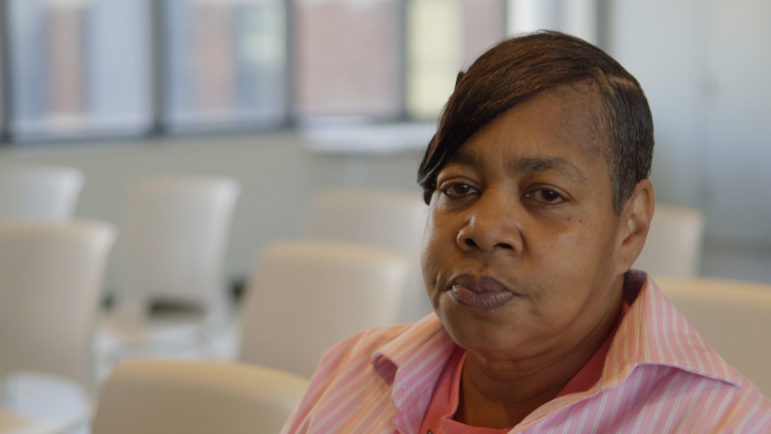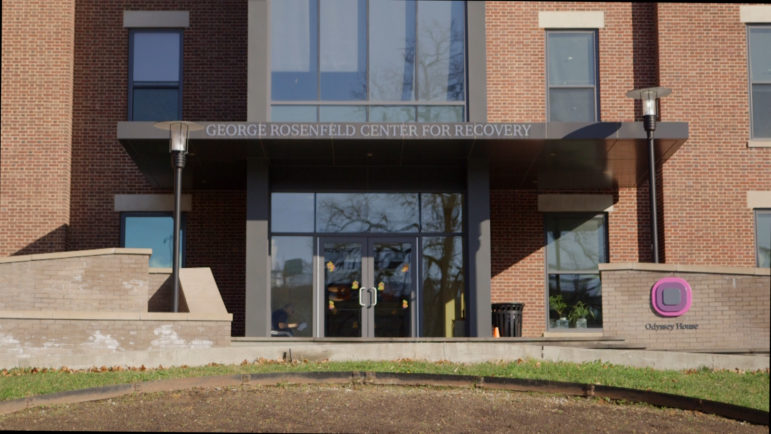By Emma Davis
City Limits

Tamara Morgan, 58, attends a seminar on heart health for residents of Odyssey House’s George Rosenfeld Recovery Center on Dec. 5, 2019 on Ward’s Island, New York City. A mother of eight and grandmother of four, Morgan is in treatment for heroin addiction at the center’s ElderCare program.
After nearly 40 years of snorting heroin, Tamara Morgan almost died from two sniffs.
Morgan, 58, had raised her eight children in Bushwick, Brooklyn while managing a $200-a-day habit. That afternoon in August, Morgan’s daughter had just stepped out of the room when Morgan decided to test her latest bag of heroin. One sniff in each nostril, and she was out.
Morgan woke up from that overdose and got high again, but the next one was different.
“When I opened my eyes, I heard my daughter telling my son on the phone that ‘Mommy is not coming back. They can’t get her up,’” Morgan said. “I never was scared of anything. That scared me.”
Morgan had used heroin containing fentanyl, a synthetic opioid involved in the majority of drug poisoning deaths in New York City in 2018, according to the Department of Health. Her experience reflects the increasing number of opioid overdoses among older adults nationwide, due to both recreational and prescription use.
Aging users are a growing concern
Drug overdoses in adults ages 55-64 have risen six-fold since 1999, representing the greatest percentage change of any age group, the Center for Disease Control reported in 2018. With a fifth of the United States’ population already over 60, the number of older adults with substance abuse disorder is projected to double from 2002-2020, a study from the U.S. Department of Health and Human Services found.
In New York City, the number of fatal opioid overdoses among people ages 55-84 has been increasing for the last four years, reaching 29 percent of the total opioid overdose deaths in 2018, according to the Dept. of Health.
New York City is home to many long-term heroin users, whose presence has contributed to the overdose rate. In contrast to rural America, “New York City has always had a large heroin market and a large cohort of people who use heroin,” said Michelle Nolan, a senior epidemiologist with the Dept. of Health. These users are “newly aging into this older age group.”
While the percentage of overdose deaths related to heroin has been decreasing since 2015 in New York City, in 2018 more than a quarter of those fatalities involved adults ages 55-84, according to Dept. of Health data.
At Montefiore Hospital in the Bronx, more than half of the 1,000 patients receiving medication-assisted treatment for opioid addiction are over 55, said medical director Dr. Melissa Stein. Citywide, the same age group represented almost 20 percent of new admissions to methadone treatment in 2016, per the Dept. of Health.
Stein believes that improved care for HIV, hepatitis C, and other diseases has helped Morgan’s generation of heroin users survive to middle age. Referring to the overdose rate among those over 55, Stein suggested that “part of why so many people are older is just they’re staying alive longer.”
Yet the introduction of fentanyl, an opioid 100 times more potent than morphine, has put these older heroin users at risk. Manufactured cheaply in China and imported throughout the United States, fentanyl can be deadly in doses as low as 2 milligrams, according to a briefing from the Drug Enforcement Administration. That amount of powder is smaller than the surface of a fingernail.
Asked about age-specific interventions in New York City’s opioid crisis, Nolan said the Dept. of Health recently held an educational event at an assisted living facility in the Bronx. Residents and community members learned to administer naloxone, which reverses the effects of opioid overdose.
Morgan, meanwhile, has already lost two friends her age to fentanyl-tainted heroin. “One day, the [dealer] ran out, and they sent somebody to buy them a bag,” she said. “One $10 bag took their life.”
Her own encounter with fentanyl convinced her to seek addiction treatment for the first time since 1998, when she spent a year in rehab to avoid losing custody of her children. “I figured, all the dope I sniff, can’t nothing put me out,” said Morgan. “The fentanyl let me know that’s a lie.”
The prescription problem
But heroin and fentanyl aren’t the only opioids harming older adults. Prescription pills are also a problem, experts say.
A third of all Medicare recipients filled an opioid prescription in 2016, including 500,000 for high doses, according to a U.S. Department of Health and Human Services report subtitled “Concerns about Extreme Use and Questionable Prescribing.” In New York City, 31 percent of overdose deaths involving prescription opioids in 2018 occurred among adults over 55, per Dept. of Health data.
A recent study in the British Medical Journal found that Tramadol, the opioid most commonly prescribed to Medicare beneficiaries, may be just as addictive as oxycodone and other more tightly controlled substances.
However, doctors often assume that seniors are at lower risk of developing an opioid addiction, said Mary Carter, an associate professor of gerontology at Towson University. “There’s a sense that older adults are not susceptible, and that when they take these drugs, they take them only because they need them.”
As a researcher, Carter found the opposite to be true. Her study in the journal Innovation in Aging showed that seniors’ opioid-related visits to emergency departments in the United States increased by 220 percent from 2006-2014.
“Somewhere around six to seven older adults every hour are visiting emergency departments with [opioid] misuse-related disorder,” Carter said.
Dr. Sean Morrison, a gerontologist at Mount Sinai Hospital, says that doctors don’t receive enough training on prescribing overall, let alone on dispensing opioids. For seniors, who have slower metabolisms and may be taking multiple medications, a doctor’s imprecise dose can lead to a hospital visit.
“The doses used in older adults are much lower than in younger adults,” said Morrison. “[Opioids] can be quite dangerous if not used properly.”
Some seniors managing long-term opioid prescriptions also fail to realize their level of dependence. Although there is no consensus on the risk of opioid dependence among older adults, a 2010 study of long-term, non-cancer pain patients found the rate to be as high as 26 percent.
Dr. Michael Bogaisky, a gerontologist at Montefiore Hospital, has seen firsthand what happens when dependent older adults lose access to opioids. He has treated dementia patients going into withdrawal while in the hospital, which can be difficult for providers to recognize.
“People getting up, falling, or getting combative, not being able to express themselves,” Bogaisky said of the patients’ symptoms. “Nobody realizes how often they were really taking the medication, or sometimes even if they were on it.”
Bronx resident Robert Jones, 63, started OxyContin in 2014 to treat pain from a gunshot wound to his spine. A former heroin user, he had been in recovery for almost a decade and was employed in a print shop.
When the clinic providing his opioid prescription closed abruptly, Jones was forced to confront his dependence. “I was in pain, but it wasn’t about pain. It was about me being sick,” said Jones, recalling his fear of entering withdrawal at work.
Feeling he had no other choice, Jones said, “I went and got me a bag of dope.”
Pain patients feel penalized
In recent years, doctors have hesitated to dispense opioids at all. For older adults such as Jones, the change comes too late.
For “legacy patients,” whose high-dose prescriptions for pain relief often date back to the 1990s, the shift represents a potential threat to their treatment.
“The [prescribing] guidelines, which really were not evidence-based, suggested that opioids after acetaminophen be first-line therapy,” said Morrison. “What we’ve seen now is the pendulum swinging way the opposite direction.”
Dr. Rosanne Leipzig, a gerontologist and palliative care specialist at Mount Sinai, has also questioned the past approach to prescribing opioids.
“When we were in training, we always gave a month of everything. It didn’t matter what it was,” said Leipzig. “If you go to the emergency room because you have a muscle spasm, [you shouldn’t get] a month’s supply of opioids.”
But as the wife of a pain patient, Leipzig is frustrated by the stigma opioid users face. Her spouse, 72-year-old Ora Chaikin, lives with several autoimmune disorders, whose excruciating symptoms include mouth ulcers and joint degeneration.
“At one point, [Ora] was an artist making jewelry, and there’s no way with her hands the way they currently are that she could do that,” Leipzig explained. “In fact, it’s very hard for her to even hold anything.”
Chaikin says opioids have helped her remain functional despite some lingering pain.
At first, she resented her opioid prescription, sometimes throwing the pills away or flushing them down the toilet. “I didn’t want to be labeled an addict or become dependent, actually. I just felt that I could beat [the illness] some other way,” Chaikin said during a panel at the National Academy of Medicine in 2018.
By the time Chaikin accepted her need for opioids, the Drug Enforcement Administration had begun cracking down on pharmacies for violations of the Controlled Substances Act. Around 2014, her pharmacy benefits provider sent her a letter announcing her dose exceeded the maximum and was being cut in half. Leipzig had to petition the company’s chief medical officer to prevent Chaikin from going into withdrawal.
Last year, Chaikin switched to a mail-order pharmacy because a local store owner “made [her] feel like a criminal” for the strength of her opioid prescription.
“The judgment that I get… that’s probably the worst problem for me, taking opioids,” Chaikin said. “Every month, I worry about being able to get them.”
Real needs, rare treatment
For seniors using heroin, on the other hand, the challenge lies in accessing addiction treatment.
Despite Medicare’s expanded coverage of buprenorphine and other medications used to address opioid addiction, “most of the drug treatment programs don’t cater to older adults,” said Bogaisky. Rehab facilities often lack the capacity to care for seniors with impaired hearing or mobility or other medical needs related to aging.
Nationwide, less than 18 percent of recovery programs are designed for people over 65, per a 2003 study from the University of Iowa. In New York state, only three facilities are specialized for older adults, according to the Office of Addiction Services and Supports (OASAS).
“Although older adults can be impacted by addiction just as much as young people, substance use disorders can be particularly hard to diagnose among this age group,” OASAS wrote in an email statement. “In addition, many older adults are more reluctant to enter treatment.”

Odyssey House’s ElderCare, one of the only three treatment programs in New York state specialized for older adults with addiction, is located within the George Rosenfeld Center for Recovery on Ward’s Island, New York City, pictured here on Dec. 5, 2019.
Odyssey House’s ElderCare, a residential recovery program for people over 55, is the sole provider focused on older adults in the New York City area.
Morgan, a resident of ElderCare since August 2019, had no idea the program existed until a detox counselor recommended it. “I was like, ‘Really? They got something for senior citizens?’” she said. “[I] thought it was a joke.”
Critics of ElderCare have asked the co-founder, Peter Provet, Ph.D., why he’s diverting resources from younger addicts.
“Many people look at the addict as someone who’s making a choice just to use drugs,” said Provet, the president of Odyssey House, a network of rehab facilities in New York City. “So the old drug addict, who’s been at it by definition longer, is seen as someone just choosing that lifestyle for many many years.”
However, that history of substance abuse can become a force for change, Provet said. “[These adults] have seen enough. They’re fed up.”
Adults over 55 with substance abuse disorder may even have better outcomes than younger patients a year after treatment, a study from the Veterans Affairs healthcare system in Palo Alto, California found.
Grateful to be alive and given a second chance, Morgan agrees that her age is motivational. “My intentions are to be clean forever because, like my kids say, ‘You had a nice run. You had your fun. It’s over now. You got to think about the grandkids and all.’”


